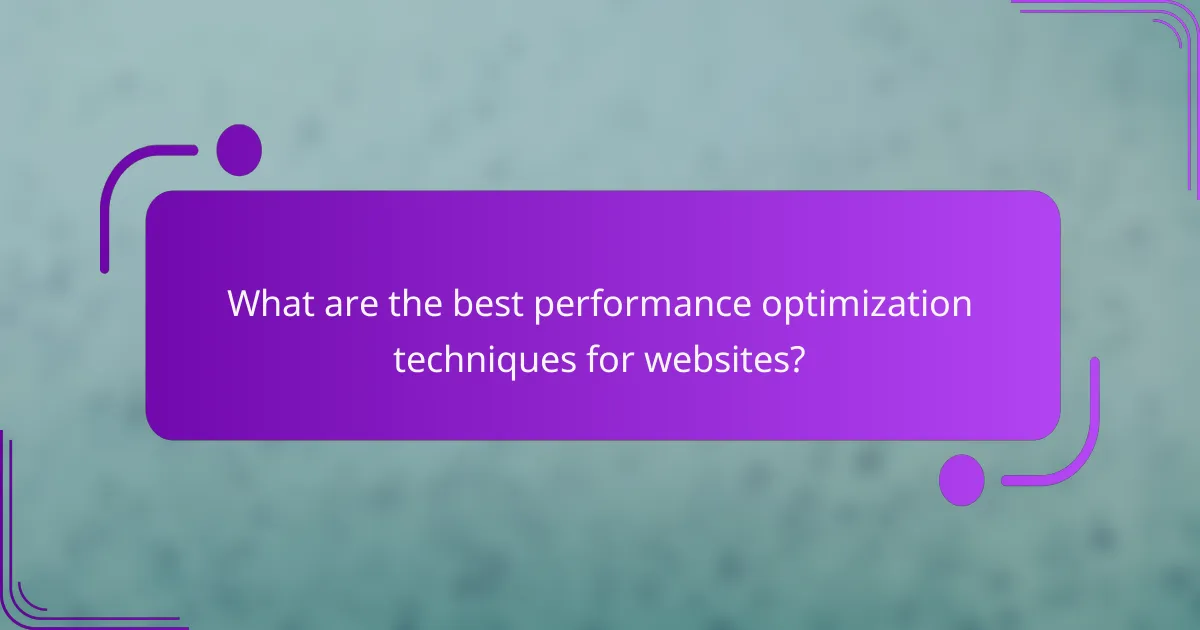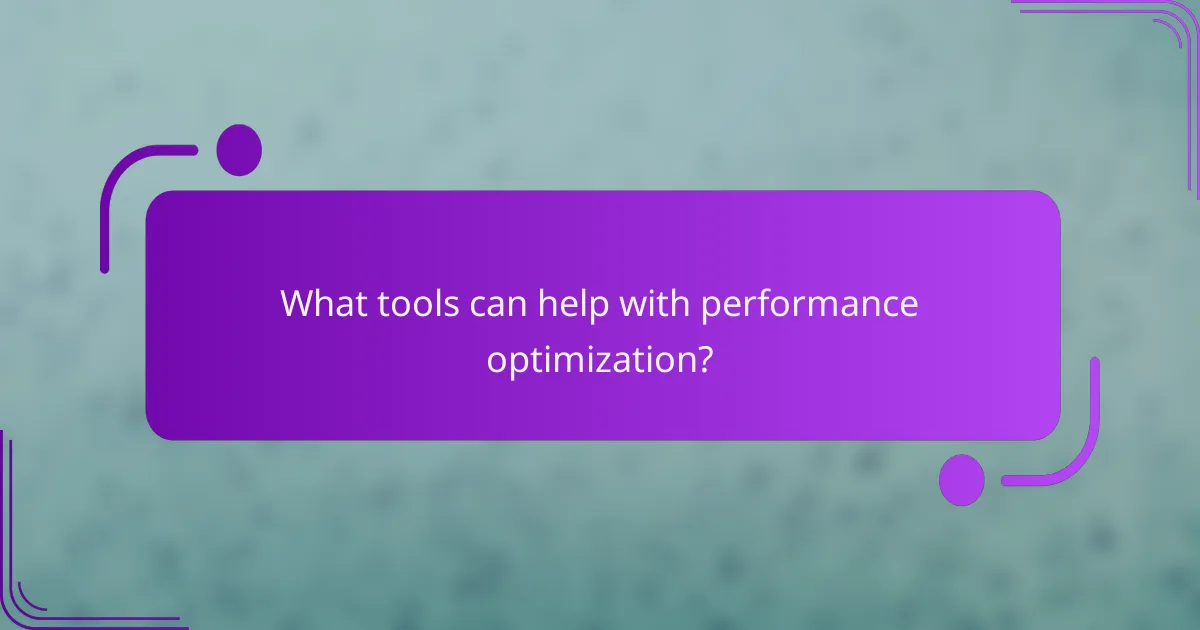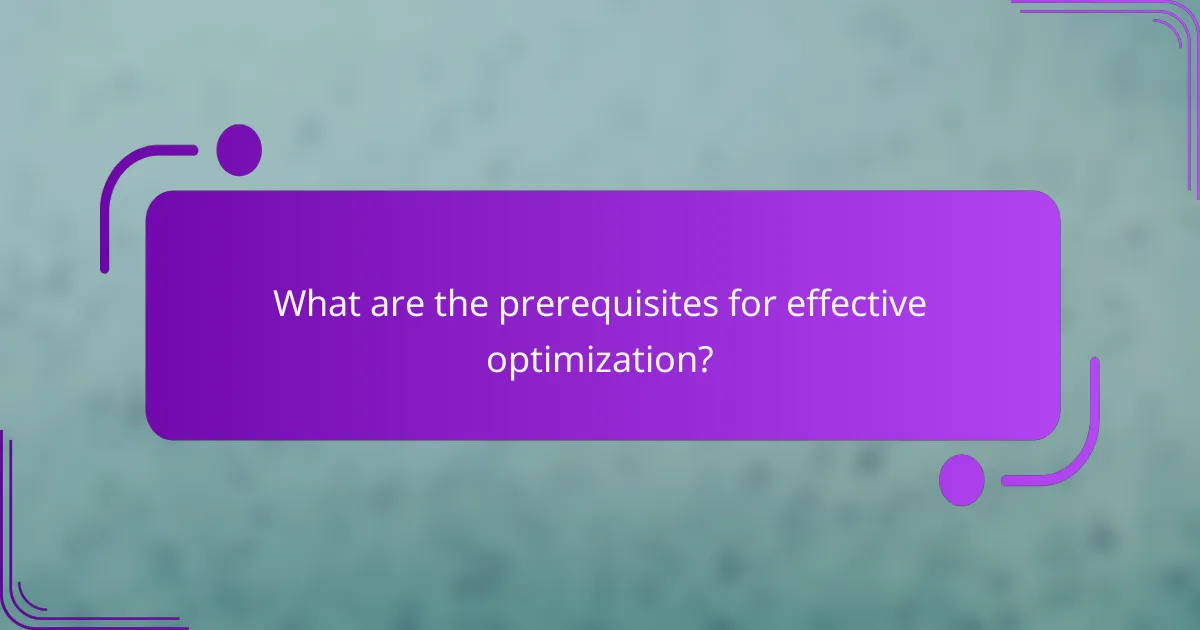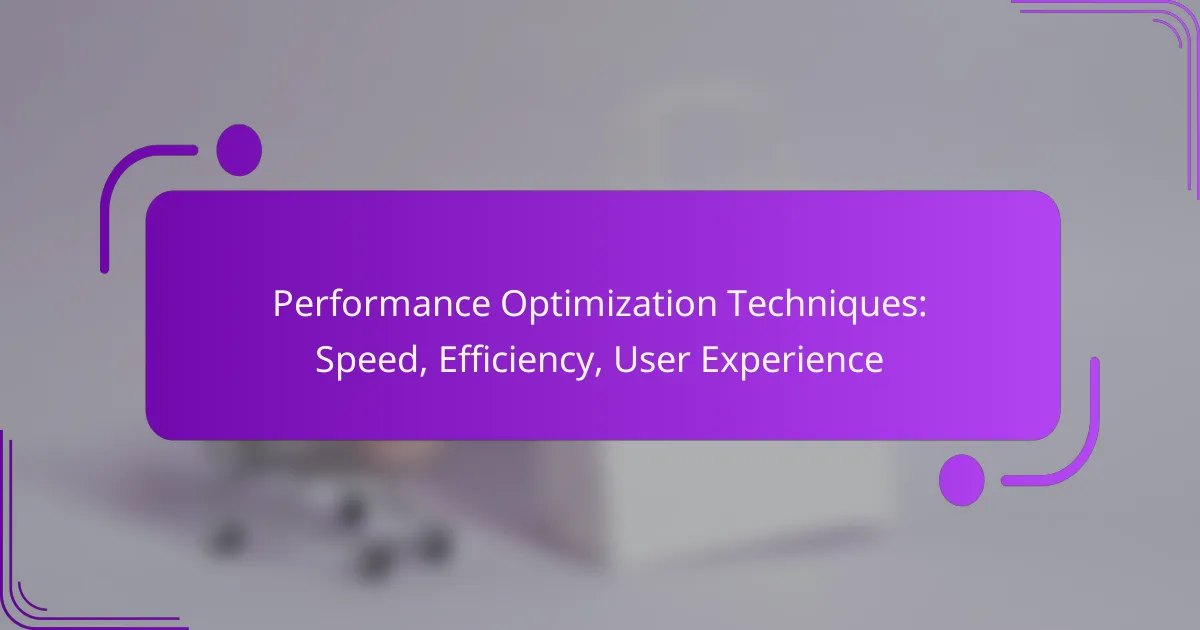Performance optimization techniques are essential for enhancing the speed, efficiency, and overall user experience of websites. By implementing strategies such as minimizing file sizes, optimizing images, and utilizing browser caching, developers can significantly improve load times and user satisfaction. Additionally, leveraging tools that analyze website performance can help identify areas for further enhancement, ensuring a seamless interaction for users.

What are the best performance optimization techniques for websites?
The best performance optimization techniques for websites focus on enhancing speed, efficiency, and user experience. Key strategies include minimizing file sizes, optimizing images, leveraging CDNs, implementing browser caching, and utilizing lazy loading.
Minification of CSS and JavaScript
Minification involves removing unnecessary characters from CSS and JavaScript files without affecting functionality. This process reduces file sizes, leading to faster load times and improved performance. Tools like UglifyJS for JavaScript and CSSNano for CSS can automate this task.
When minifying, be cautious of potential issues with code readability and debugging. Always maintain a backup of the original files and consider using source maps for easier troubleshooting.
Image compression strategies
Image compression reduces the file size of images without significantly impacting quality, which is crucial for faster page loading. Techniques include using formats like JPEG for photographs and PNG for graphics, as well as tools like TinyPNG or ImageOptim for effective compression.
A good rule of thumb is to aim for a balance between quality and size, targeting a reduction of 50-70% in file size. Always test images on various devices to ensure they display correctly across different screen sizes.
Utilizing Content Delivery Networks (CDNs)
CDNs distribute website content across multiple servers worldwide, allowing users to access data from a location closer to them. This reduces latency and speeds up loading times, enhancing user experience significantly. Popular CDN providers include Cloudflare and Akamai.
When choosing a CDN, consider factors such as geographic coverage, pricing, and ease of integration. Many CDNs offer free tiers, making them accessible for small to medium-sized websites.
Browser caching implementation
Browser caching stores static files locally on a user’s device, reducing the need to fetch them from the server on subsequent visits. This can dramatically improve load times for returning users. Setting appropriate cache-control headers helps manage how long files are stored.
Implement caching for assets like images, CSS, and JavaScript files. A common practice is to set cache durations of one week to one month, depending on how frequently content changes.
Lazy loading for images and videos
Lazy loading defers the loading of images and videos until they are needed, such as when they enter the viewport. This technique can significantly reduce initial load times and improve performance, especially on content-heavy pages.
Implement lazy loading using native HTML attributes like loading=”lazy” or JavaScript libraries. Ensure that this feature is compatible with various browsers to maintain a consistent user experience.

How can speed impact user experience?
Speed significantly influences user experience by affecting how quickly users can access content and interact with a website. Faster load times lead to higher satisfaction, while delays can frustrate users and drive them away.
Correlation between load times and bounce rates
There is a strong correlation between load times and bounce rates, with studies showing that even a one-second delay can increase bounce rates by a notable percentage. Users tend to abandon pages that take longer than a few seconds to load, often opting for faster alternatives.
To minimize bounce rates, aim for load times under three seconds. Regularly test your website’s performance using tools like Google PageSpeed Insights to identify and address slow-loading elements.
User engagement metrics affected by speed
Speed affects various user engagement metrics, including time on site, page views per session, and conversion rates. Faster websites generally see higher engagement, as users are more likely to explore additional pages and complete desired actions.
For instance, e-commerce sites can experience significant increases in sales when load times are optimized. Aiming for quick load times can enhance user retention and boost overall site performance.

What tools can help with performance optimization?
Several tools can significantly aid in performance optimization by analyzing speed, efficiency, and user experience. These tools provide insights into various aspects of website performance, helping you identify areas for improvement.
Google PageSpeed Insights
Google PageSpeed Insights evaluates the performance of your web pages on both mobile and desktop devices. It provides a score from 0 to 100, with higher scores indicating better performance. The tool offers specific suggestions for improvement, such as optimizing images and leveraging browser caching.
When using PageSpeed Insights, focus on the recommendations that can yield the most significant impact. For example, improving server response times can often lead to noticeable speed enhancements. Aim for a score above 90 for optimal performance.
GTmetrix for performance analysis
GTmetrix combines Google Lighthouse and Web Vitals to provide a comprehensive analysis of your website’s performance. It breaks down loading times, page size, and the number of requests, allowing you to pinpoint bottlenecks. The tool also offers a waterfall chart that visualizes the loading sequence of your resources.
Utilize GTmetrix to track performance over time by setting up regular monitoring. This can help you understand how changes to your site affect loading times. Look for recommendations such as reducing redirects and minifying CSS and JavaScript to enhance speed.
Pingdom for uptime monitoring
Pingdom is primarily focused on monitoring website uptime and performance. It alerts you when your site goes down, ensuring you can respond quickly to minimize downtime. The tool also provides insights into page speed and performance trends over time.
For effective use of Pingdom, set up alerts for downtime and review performance reports regularly. This will help you maintain a reliable user experience. Aim for a 99.9% uptime target to ensure your site is consistently accessible to users.

What are the key metrics to measure performance?
Key metrics for measuring performance focus on how quickly and efficiently a website responds to user requests. These metrics help identify areas for improvement in speed and user experience, ultimately impacting user satisfaction and engagement.
Time to First Byte (TTFB)
Time to First Byte (TTFB) measures the duration from when a user requests a webpage until the first byte of data is received from the server. A lower TTFB indicates a more responsive server, which is crucial for enhancing user experience.
To optimize TTFB, consider using a reliable hosting provider, implementing caching strategies, and minimizing server response times. Aim for a TTFB under 200 milliseconds for optimal performance.
First Contentful Paint (FCP)
First Contentful Paint (FCP) measures the time it takes for the first piece of content to be rendered on the screen after a user navigates to a webpage. This metric is essential as it gives users a visual indication that the page is loading.
To improve FCP, prioritize loading critical CSS and JavaScript, optimize images, and utilize lazy loading techniques. A target FCP of under 1 second is ideal for a smooth user experience.
Largest Contentful Paint (LCP)
Largest Contentful Paint (LCP) tracks the time it takes for the largest visible content element on the page to load. This metric is vital as it reflects the perceived loading speed from the user’s perspective.
To enhance LCP, ensure that the largest content elements, such as images or videos, are optimized and served quickly. Aiming for an LCP of under 2.5 seconds is recommended to keep users engaged and satisfied.

What are the prerequisites for effective optimization?
Effective optimization requires a solid understanding of both the technical and user experience aspects of a website. Key prerequisites include a well-structured website architecture, performance monitoring tools, and a clear set of goals for user engagement and speed.
Understanding website architecture
Website architecture refers to the structural design of a website, which impacts both performance and user experience. A well-organized architecture ensures that content is easily accessible, which can significantly enhance loading times and navigation efficiency.
To optimize your website architecture, consider implementing a clear hierarchy with logical categories and subcategories. Use descriptive URLs and ensure that internal linking is intuitive. This not only aids search engine indexing but also improves user navigation.
Common pitfalls include overcomplicating the structure or neglecting mobile optimization. Aim for a flat architecture with fewer clicks to reach important content, ideally within three clicks from the homepage. Regularly review and update your architecture to adapt to user behavior and content changes.
